Photos: Kip Miller
But Galicia
is best known as a place of pilgrimage and one of Christendom’s holiest
sites. Two thousand years ago, James the Apostle spent 30 years in these
parts spreading Christianity to the pagan Celts. After he was beheaded
by Herod Agrippa in Palestine, his remains were transported back to Galicia
and then lost to obscurity. Some 800 years later, a shower of stars guided
a hermit to his burial site in a forest. James’s relics were declared
to be authentic by the local bishop and a chapel was built on the very
spot, evolving over the centuries into the great Cathedral of Santiago
de Compostela. The rest is history. The cathedral immediately became a
major pilgrimage site, rivaling Jerusalem and Rome. From the Middle Ages
onward pilgrims from all over the world undertook several versions of
the 450 mile journey to Santiago known as “The Camino,” often
beginning on the French side of the Pyrenees and continuing on well-marked
routes leading to the cathedral and the Saint’s crypt. The Camino
is even more popular today. Since the release of “The Way,”
the 2011 Hollywood film starring Martin Sheen, there has been a sizable
uptick in pilgrims. “Last year over 250,000 were counted,” says
Jesús. “I’ve even made the journey myself!”
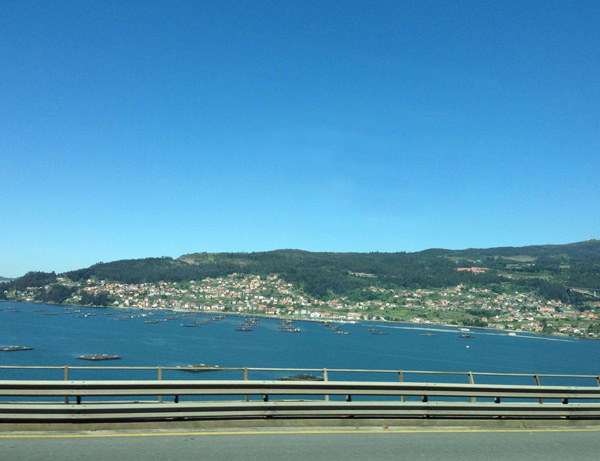
Historic Pontevedra is the jewel of the Rias Baijas region in Galicia, an indented coastline where fishing predominates.
It is raining throughout the Iberian Peninsula, but so far we’re keeping ahead of it. Our bus races north, bypassing Vigo, a city of 300,000 that maintains Galicia’s largest fishing fleet. Here, coastal islands attract hordes of summer tourists. Yet most of the region is sparsely populated, a land of a thousand villages surrounded by stone walls and fields of gorse and broom. Jesús points to a hórreo, an elevated stone granary designed to keep grains dry during Galicia’s frequent storms. “You will find hórreos everywhere,” he tells us. “They are a necessity in a region with a hundred different words for rain!” As we cross our first ria, I gaze at a flock of seagulls in hot pursuit of several fishing boats heading home. Straight ahead are endless rows of mussel platforms. “This is shellfish heaven,” Jesús explains. Inside the rias and off Galicia’s coastal islands are ancient sea beds where a profusion of crustaceans-and mollusks--including barnacles, cuttlefish, and octopus--are harvested. “When we get to Santiago and walk on Rua do Franco, you will see an amazing assortment of seafood on display in restaurant windows,” he promises.
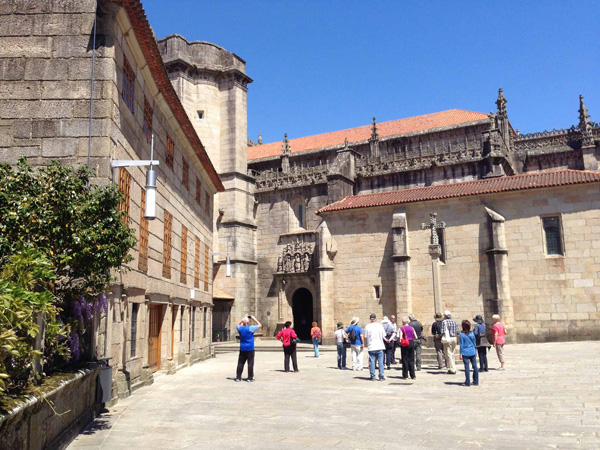
Pontevedra’s exquisite Basilica of Santa Maria de la Mayor is renowned for its elaborate Baroque sculptures.
Bordered by the Lérez River and the Atlantic is Pontevedra, one
of Galicia’s jewels, boasting a pedestrianized old town chock full
of historic churches, lovely squares and granite alleys lined with colonnades.
Jesús leads us past a popular eatery specializing in octopus. “It’s
called a pulpería and the octopus is simply boiled until it’s
tender and then seasoned with olive oil, sea salt and paprika. You must
try it,” he insists. We pause in front of the City Hall, and then
head down a broad street lined with mansions adorned with wrought iron
balconies and heraldic coats of arms. “Pontevedra once had a sizable
Jewish community,” says Jesús, stopping by a tiny street that
was the entrance to the former Jewish quarter. “Sadly, well before
the Inquisition, there was a great massacre here in 1391.” In its
heyday, the Jewish community had been heavily involved in craft guilds
and ship-building. According to local lore, Columbus was born in Pontevedra
and not in Genoa, the son of Jewish wool traders. “His largest ship,
the Santa Maria, a carrack with three masts, was built here,” Jesús
divulges. Directly ahead is the impressive 16th century basilica of Santa
Maria la Mayor, a Baroque masterpiece with a ribbed vault in the shape
of a four-leaf clover. We gawk at elaborately carved sculptures adorning
its western façade. “Look to the right of the door,”
Jesús points. “That’s Saint Jerome wearing glasses!”
A pleasant stroll on Isabel II Street ends up at Cinco Calles, a tiny square dominated by a cross with an expressive sculpture of Adam and Eve on the verge of devouring the forbidden fruit. “What a great backdrop for all the tapas bars here!” says my husband. We continue to Ferrería Square, the largest plaza in town, built around a flower-filled park with a tall fountain and surrounded by arcades that one housed blacksmith workshops. Nearby rise the Baroque towers of La Peregrina, a church dedicated to Pontevedra’s patron saint and a popular stop for pilgrims headed to Santiago. “Ach, I could easily stay here for a few days!” I sigh. “It’s so peaceful and there is a wonderful old food market to explore…”
Pontevedra
is brimming with trendy restaurants radiating from Praza do Teucro. We
wander down Rua Conde de San Román with Kathy an Eric, our longtime
traveling friends. Straight ahead is Meigas Fóra y Anxemí,
a modern bistro with a logo of a flying witch crowning the menu. We take
an empty table for four under an umbrella. “I hope the logo is a
metaphor for out-of-this-world cooking,” teases Eric. And it is!
We devour crepes stuffed with octopus, tetilla cheese and turnip tops,
and a salad of warm organic greens tossed with juicy tomatoes and oranges.
But more than the food, their Pan da Vila--a crunchy, aromatic bread made
with local organic wheat—is a standout, especially when dunked into
extra virgin olive oil.
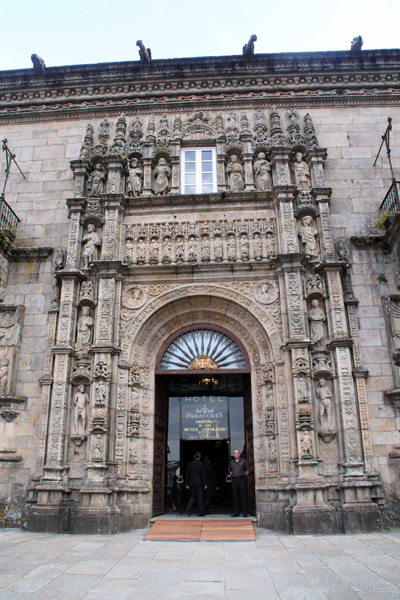
A Plateresque portal greets guests at the Parador de Los Reyes
Catolicos, Spain’s most celebrated historic hostelry.
A half hour’s drive brings us to Santiago de Compostela’s doorstep. This well-preserved city, a UNESCO World Heritage site, is renowned for a historic quarter packed with an ensemble of granite buildings that radiate from Praza do Obradorio, a huge square fronting St. James’s Cathedral. “The old town ranks as one of Europe’s grandest,” says Jesus as we walk across. “Wow, look at where we are staying!” exults Kathy, pointing to our prestigious hotel, the Parador de Los Reyes Católicos, on the cathedral’s left. First opened 500 years ago as a hospital and pension for the endless stream of pilgrims making The Camino, it was converted for tourism in 1953.
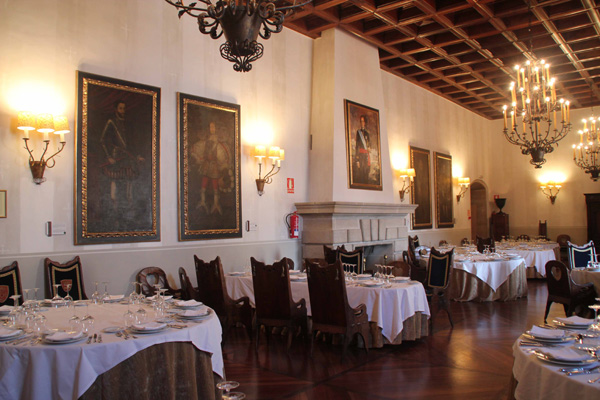
Formal tables are set for a special party in one of the Parador’s regal banquet rooms.
“This property is built around four cloisters,” explains Antonio, the assistant manager, as he guides us around the property. “There are 254 guest rooms and out of Spain’s 100 paradores, we are the most profitable.” We begin at the massive Plateresque entry door, continuing through a maze of staircases and elegant public spaces. Enormous dining rooms are lined with tables set for formal events. “They must have several kitchens to be able to serve so many people!” I remark to my husband. We stroll down antique filled corridors. At one corner circular stairs lead to the upper sacristy. “The acoustics here are so excellent that even patients who were isolated in the death room could hear mass celebrated in the chapel below,” Antonio explains. “Each August we hold master guitar classes in this room. Years ago Andrés Segovia used to teach here.” Antonio’s cell phone buzzes repeatedly. “Disculpe, I must deal with a problem,” he apologizes as he disappears down the hall.
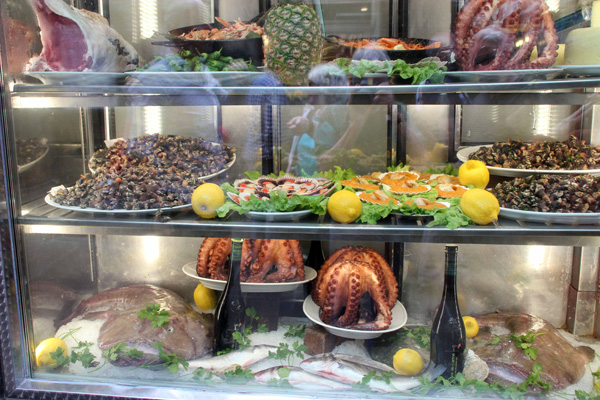
On Rua do Franco in Santiago de Compostela, El Rapido’s restaurant window showcases scallops, barnacles, octopus and other seafood, luring in scores of patrons.
“Tomorrow is Ascension Day, a special holiday,” says Jesús as we embark on a quick orientation of Santiago’s cobbled lanes. “Expect a lot of late night noise and street music.” We wander down Rua do Franco, and sure enough, restaurant windows—most notably the one at El Rápido--are filled with eye-popping displays of octopus, monk fish, barnacles and other seafood on ice. Three street musicians are playing baroque selections. The music bounces off the old stone walls, transporting me back in time. ”Santiago became the world’s first major tourist destination,” comments Jesús as we stroll past souvenir shops crammed with felt hats, scallop shell memorabilia and walking sticks. There are many legends about the scallop shell, the symbol of The Camino. One version claims that the shell dates back to the year the Apostle’s remains were being returned to Galicia by his disciples. They were lost at sea, but miraculously washed up on shore all encrusted with scallop shells. For centuries pilgrims have been guided on their arduous journey by shells hung on doorways, walls and trees, or embedded in pavements. A sweet aroma wafts from a bakery with artful displays St. James cakes and other local delicacies. “It’s a very simple recipe,” says a smiling salesgirl as I fixate on an oversized round cake. “Just ground almonds, sugar and eggs. Here, have a taste of our caprichos and perlas,” she insists. The cookies are irresistible. We purchase a box to share with the group. “How about a sip of our aguardiente de orujo?” she refuses to give up as we walk out the door.
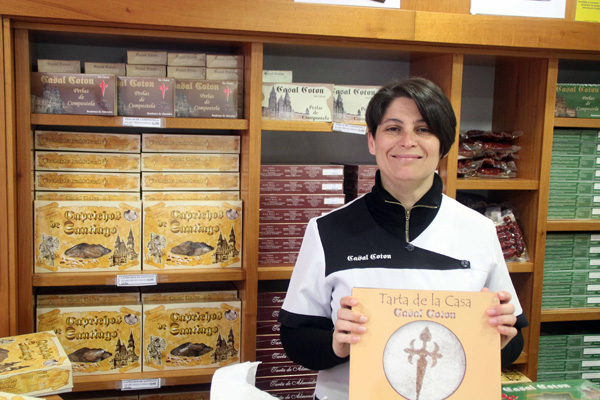
At Casal Coton, one of Santiago’s premier pastry shops, a salesgirl showcases its signature St. James cake.
Not far from Rua do Franco, a large park is packed with a holiday crowd
sprawled out on the grass. I watch a group of squealing toddlers running
in a circle. The scent of chorizo wafts out of a tiny grill house somewhere.
Gelato stands with long lines of customers are quickly selling out of
favorite flavors. We make our way back to the Praza do Obradoiro where
half a dozen newly arrived pilgrims have gathered, their curved canes
and backpacks plopped on the ground. They look scruffy, but deliriously
happy to have made it in time for the holiday. “Tomorrow the giant
botafumeiro (censer) will be swinging inside the cathedral,” Jesús
had told us. “The central nave will be packed with pilgrims.”
I peer out at the square in the evening. A light drizzle has arrived and Santiago’s old buildings are glistening. Xenebre, the parador’s casual tavern, is staging a tapa extravaganza for us. Out comes a parade of small dishes: grilled scallops, razor clams, octopus, savory empanadas, crispy fried vegetables and a Galician rendition of paella, to mention just a few. The waiters pour several local wines, first and foremost a chilled Albarino, an aromatic white produced in the lower rias region that thrives in this damp climate. We head back to the comfort of our rooms, but sleep eludes us. The music and raucous merrymaking in Santiago’s streets penetrate our shuttered windows until the wee hours.
”Yes,
I am Italian,” says our city guide Italo under an overcast morning
sky. “But my first love is Spain.” According to Jesús,
we are lucky to have him. “Italo will bring Santiago’s cultural
history to life as no one else can,” he declares. “Let’s
have a look,” Italo begins as we face the cathedral, part of it under
scaffolding. “Construction of a Romanesque church began about 800
years ago, but its style evolved to Gothic and Baroque over the centuries.
Just inside the façade, the Portico da Gloria was carved by Mateo
in the 12th century. It portrays humanity’s walk through life, starting
with the original sin of Adam and Eve and eventually reaching purity through
Christ and St. James at the top. The 12 apostles are all here, with St.
James the fifth on the left,” he enumerates. We fixate on a central
column covered with finger indentations made by thousands of pilgrims
over the centuries. Above it sits St. James wearing a hat and holding
a walking stick, just like a pilgrim. I zero in on the carvings. There
are pagan elements present, such as gargoyles and wild animals, probably
added to protect worshippers against evil, a nod to Galicia’s obsession
with witches and the occult. “Notice the chains,” Italo explains.
They indicate that the church is an independent refuge, like an embassy
offering asylum to all.” He points to a small side street to the
left of the cathedral. “That’s the road that goes to Finisterre,
the final stop on The Camino. When pilgrims arrive there, they burn and
bury their traveling clothes, signifying that they have reached purity.”
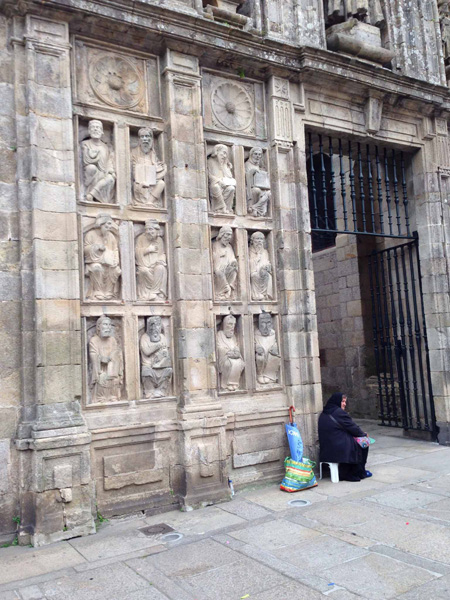
The Holy Gate of Forgiveness on the Quintana side of St. James’s Cathedral opens
its portals to pilgrims this year through special permission of the Pope.
“The Benedictine monks were the very first to establish The Camino,” Italo remarks as we swing north past the huge Monastery of San Martin. “Here, under the protection of the archbishop, Santiago’s old Jewish quarter once flourished on the narrow Rua do Jerusalem. During the Inquisition many local Jews used to hang hams in front of their houses to confuse the authorities. Sadly there are none left today, although that may change. A new law was recently passed that extends citizenship to Jews of Sephardic origin,” he adds. Straight ahead is Cervantes Square, the notorious site of witch burnings and executions. “Cervantes was Galician and that’s why his obelisk is here,” Italo explains. He leads us down a street filled with Art Deco and Modernist buildings. Here, houses are built over ground floor shops with glassed gallerias above. We wind back to the cathedral, pausing in front of the Holy Gate of Forgiveness on the cathedral’s elegant Quintana facade. “The Pope has given special permission to open the gate this year,” Italo reveals. “This is the main entrance for the thousands of pilgrims expected on the holiday. Those who walked a minimum of 100 kilometers can qualify for a certificate called the Compostela.”
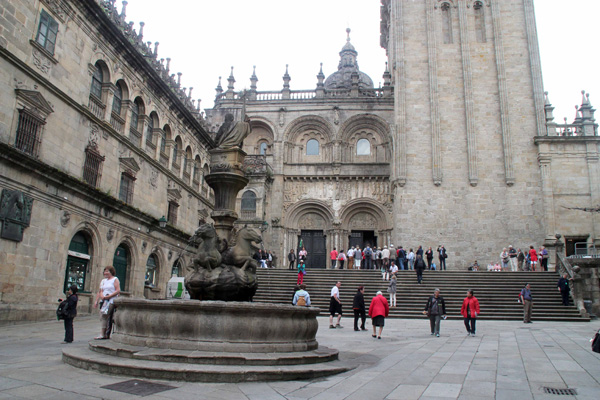
The dramatic two level Praterias Square leads to St. James’s southern portal, offering quick access to
the crypt of the saint.
The impressive two-level Praterias Square south of the cathedral is swarming
with tourists. “Now you will see the Romanesque section and its elaborate
carvings,” Italo boasts. We enter through the Porta das Praterias
(goldsmith’s portal) adorned with biblical scenes. Inside the dark
interior, we make our way through a sea of people to the silver urn where
St. James’s relics are venerated. Behind the altar rises the bejeweled
13th century statue of the saint. “Hordes of pilgrims climb a set
of stairs to reach the saint’s mantle and kiss it,” says Italo.
“And those that attend mass today will see the censer in action,
swung by pulleys that hang from the transept dome that enable it to move
at a speed of more than 65 kilometers per hour. It takes eight men--the
tiraboleiros--to get it going.” I smile at the thought of clouds
of incense filling the church with a woody fragrance. In the old days
the profusion of incense was absolutely necessary to mask the foul smell
of thousands of unwashed pilgrims!
We exit through the Portico da Gloria and wander at leisure. Strains of bagpipes beckon from a tunneled lane, a music with a decidedly Celtic air. “Are we really in Spain?” asks my husband as we approach a costumed musician playing a gaita, the main instrument of the region, characterized by three drones. I immediately notice that the gaita’s fabric reflects the blue, red and gold of Galicia, although the player is dressed in black. In a small courtyard a group of costumed youths are waiting to dance. Galicia’s culture is infused with Celtic elements while Gallego, its local language, is closely related to Portuguese. “Most locals speak both Spanish and Gallego interchangeably,” Jesús had told us. All at once, gold-vested girls with full black skirts break into a dance to the accompaniment of gaita, drums and tambourines. Men in tall boots and pointed hats move in intricate small steps as the girls twirl. In the background, another half a dozen dancers wearing wide-brimmed straw hats are waiting their turn. It’s as if we’ve entered a time warp, surrounded by centuries-old porticos and fountains and privy to the rituals of a bygone era. “How lucky that we came during this holiday!” I blurt out.
Back at the parador, a feast awaits us in Dos Reis, the stone-arched dining room that was once part of the hospital’s stables. We begin with caldo gallego, Galicia’s traditional green broth seasoned with herbs, followed by white asparagus salad. A delicate poached cod is a standout, as are morsels of marinated scallops served in the shell. Santiago’s famed almond tart provides the perfect finish. We couldn’t have asked for more. “How about if we step out on Obradoiro for a last peek?” I suggest to my husband, as we brace for the drizzle. I glance at the Colexio de San Xerome, the university building opposite the parador. To our right the Palacio de Rojai, the four-story town hall, could be part of a Hollywood movie set. “I bet it is only partly occupied,” I mutter as I survey its facade. Moss and lichens spill out of cracks and crevices in the old stones, nourished by the soggy climate. The land beyond the plaza slopes down toward the university area. Church spires twinkle mysteriously in the darkened sky. A perfect milieu for Galician witches stirring their cauldrons, I muse.
Intermittent
rain continues on the road to Leon the next morning. We arrive by noon
at Astorga, an ancient Roman stronghold and a convenient hub for pilgrims
taking the French and Southern versions of The Camino. Here Antoni Gaudi’s
Bishop’s Palace is the number one tourist attraction. Our lunch of
crusty Serrano ham sandwiches is followed by a visit to a chocolate shop.
Apparently Astorga was the very first stop for Cortez after his return
from the New World bearing crates of Aztec cacao. The locals went mad
for this new delicacy and Astorga became famous throughout Europe for
its chocolate confections. By the time we arrive at the Palace, it is
two minutes before siesta closing time. We snap a few images of its phantasmagorical
Gothic turrets under umbrella cover from afar. “I am so disappointed
we won’t see the spectacular stained glass windows inside,”
I complain. Apparently Gaudi let his imagination run wild when he designed
the palace. “Too bad he was not alive when Disneyland’s castle
was being built,” says my husband. “He would have kicked it
up a notch!”
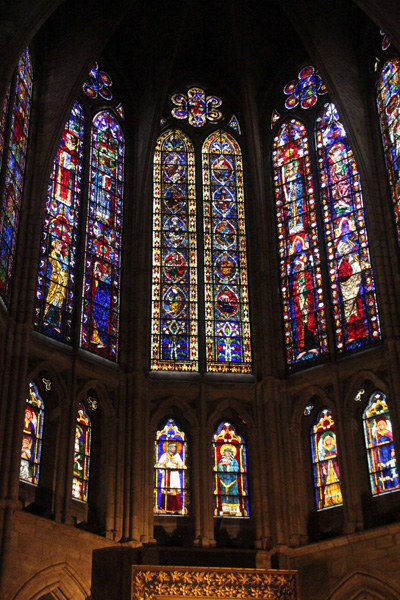
Spanning six centuries, a treasure trove of stained glass windows adorns Leon’s massive Gothic cathedral.
Ranging from Medieval to Arts and Crafts, these windows undergo continuous repair and upkeep.
Leaving Galicia behind, we continue to Leon, an important city of the
Reconquista expanded by King Ferdinand to showcase the power of Castillla
y Leon. Steeped in layers of history, it is another major stop on The
Camino. Our bus makes a beeline for Hostal de San Marcos, a massive convent
dating from the Renaissance complete with a consecrated church and museum.
Today it operates as a luxury parador, furnished with priceless antiques
and paintings. In spite of a rainstorm expected at any minute, we head
straight to Leon’s historic center led by Patricia, a local guide
and expert on the city’s artistic legacy. Gaudi left his mark here
too. She brings us to his exquisite Casa de Botines, a building originally
created for textile workers and filled with his trademark Modernist flourishes.
I zero in on a statue of St. George killing the dragon on the facade.
“Looks more like an alligator to me,” comments my husband. “Today
Botines houses a major bank,” explains Patricia. Umbrellas unfurled,
we follow her to Leon’s massive Gothic cathedral, considered a rival
of Chartres. A gust of wind blows my umbrella inside out as the downpour
begins in earnest. My back is totally soaked, my sandals soggy. I rush
inside the sandstone cathedral, renowned throughout Europe for its breathtaking
array of stained glass windows dating from the 13th to the 19th centuries,
a veritable primer on this rarefied art form. Patricia pauses in front
of the tomb of the first king of Leon and then heads to the oldest set
of windows with lead surrounds. But I am more enthralled by an ensemble
of late 19th century Arts & Crafts windows influenced by William Morris.
“Wow, these colors are so vivid,” I remark to Patricia. “They
are made entirely of stained glass and are not painted,” she explains.
“We have been restoring all of our stained glass continuously since
the great earthquake of 1755 that leveled most of Lisbon. Even though
Leon is far away from southern Portugal, the cathedral suffered great
damage.”
“Now
let’s contrast this cathedral with the Basilica of San Isidoro,”
Patricia announces as we continue to an enormous church dedicated to the
archbishop of Seville and begun in the 10th century. Under the royal mausoleum’s
mural-encrusted ceiling are the entombed remains of 23 monarchs and assorted
nobles. “Aren’t these murals especially beautiful?” she
asks. “Look at this one depicting the Last Supper!” As we head
back, I am in awe of the massive Roman walls that enclose the old quarter.
“They are constructed of ashlar and boulders surrounded by mortar,
and they shielded Leon’s residents from its numerous marauders,”
notes Patricia. “Only Al-Mansur of the Cordoba Caliphate was able
to break through these walls,” she boasts as the bus deposits us
next to the Plateresque façade of San Marcos. That evening, in
the regal dining room, we feast on a local menu: an amuse bouche of tuna
and a seafood cocktail accompanied by a glass of Cava, followed by roasted
baby lamb with fried breadcrumbs and ending with Leon’s version of
caramelized rice pudding.
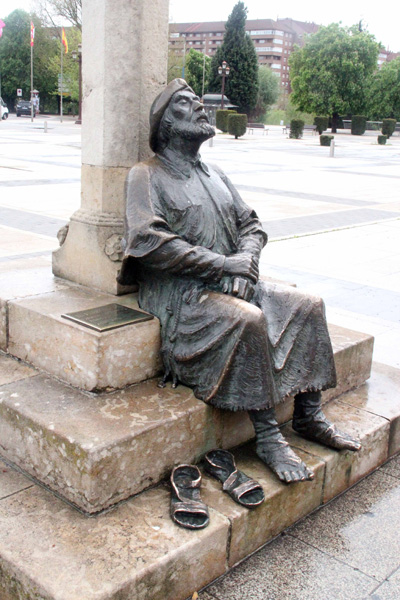
A bronze sculpture of an impoverished pilgrim faces the Hostal de San Marcos, Leon’s luxury parador. Exhausted but elated, he is already envisioning St. James’s crypt in Santiago de Compostela, some 300 kilometers away.
In the cool of morning I step outside under clearing skies. The sun is
rapidly drying the remaining puddles in front of the parador. I pause
by a large bronze statue of a pilgrim seated at the foot of a stone cross
facing the entrance. He looks weary, leaning back on the cross to rest,
his bare feet bandaged, his worn sandals plopped next to him. This pilgrim
is obviously poor and I find it ironic that he is facing an upscale parador
where guests sleep on designer sheets and eat like kings. Yet, he seems
content, as if he has already found what he was looking for. And then
I get it. Since he is not far from Santiago, this pilgrim is already envisioning
St. James’s tomb. ”And just what are you looking for?”
He seems to be asking me.
